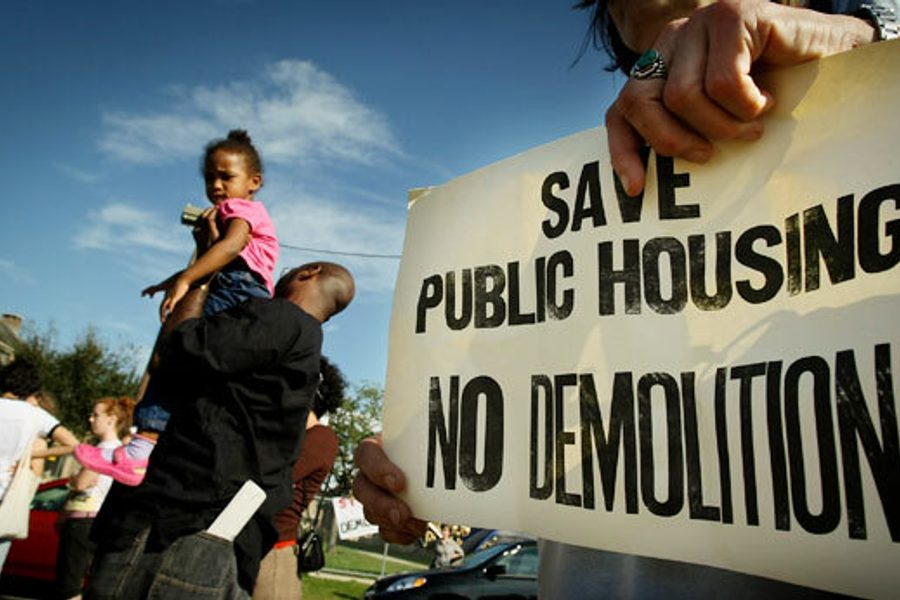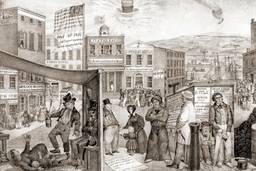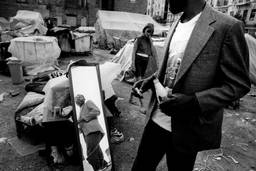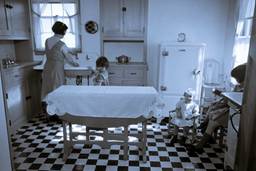Deploying Urban Space
In Rebel Cities, David Harvey says places like Tahrir Square and Zuccotti Park are key tools for revolution.
Margaret Garb

The high-rise public-housing projects that stood as monuments to failed federal policy and desperate urban poverty through the second half of the 20th century are nearly gone. Conceived in the 1930s as visionary solutions to the problem of deteriorated tenements, by the 1960s the modernist towers were viewed as “warehouses” for the urban African-American poor. St. Louis’ reckoning was among the earliest and most spectacular: The 1972 photograph of the implosion of one of the infamous Pruitt-Igoe towers marked “the death of modernism.” It was another three decades before Chicago’s most notorious projects, Cabrini Green and the massive Robert Taylor Homes, were torn down.
Left behind is an urban landscape shorn of almost all remnants of public housing’s brutal history. In St. Louis, 33 acres of the original 57-acre Pruitt-Igoe site have become an urban wilderness, a dense forest just north of the city center.
Most of Chicago’s Cabrini Green is now neat rows of town houses edging a public park and library. What’s covered over by this new bourgeois neighborhood are the radical ideals (and idealists) who imagined government could provide decent housing for urban residents; the racist city and federal policies that quickly destroyed the housing; and the displaced residents who attempted to make homes out of deteriorating high-rises.
Spaces, as French sociologist Henri Lefebvre famously observed, obscure the conditions of their own production. Almost as soon as construction is complete, buildings, parks, roads and bridges – the built environment – take on an air of inevitability, as if the city emerged naturally through an organic process. The appearance of natural growth hides dramatic inequalities in the distribution of political power, social resources and urban infrastructure. In fact, the language of evolution so often applied to urban development tends to render those inequalities as natural outcomes of organic processes. Among Lefebvre’s great contributions was to shake off the organic metaphors and focus attention on the social processes of producing cities. Cities are formed historically, the results of political struggles and competing economic interests.
Urban space, moreover, was – and continues to be – a tool in social struggles. The best-known example is Baron Haussmann’s redesign of mid-19th-century Paris so that soldiers could move quickly through the newly expanded boulevards to crush worker uprisings. The reconstruction of 19th-century European cities served the interests of state power. Lefebvre, writing in the wake of the 1968 student uprising in Paris – and a supporter and inspiration for many of those occupying the Paris streets – noted that urban space was “a means of control, and hence of domination, of power.” He could have been writing about America’s public housing, which further segregated and impoverished African-American families in northern cities.
Yet urban space can also, as has become apparent, be deployed by grassroots opposition. Activists in places like Tahrir Square in Cairo and Zuccotti Park in Manhattan made urban space a powerful force in struggles against dictators and global capital. With their concentrations of young people angered by visible economic disparities, the world’s cities have become seedbeds for political movements.
David Harvey opens his new book, Rebel Cities: From the Right to the City to the Urban Revolution, with a meditation on another favorite Lefebvre phrase, “the right to the city.” The term comes from a Lefebvre essay published just before the Paris uprisings. That right, “both a cry and a demand,” writes Harvey, is rising out of the streets in cities around the globe as a collective right to “make and remake ourselves and our cities.” Harvey hopes it will be the guiding principle for a renewed global Left.
In Rebel Cities, Harvey, a cultural geographer, social critic and prolific author, writes that the city has become a source of capital accumulation through rents, land speculation, multiple mortgage markets and corrupt real estate practices. Real estate markets kept urban capitalism afloat, for a time anyway.
Rising home ownership rates and rising consumer debt were touted as signs of an expanding middle class. Yet they failed to address the whole range of economic and political inequalities between rich and poor urban neighborhoods. Middle-class incomes stagnated and the gap between the very rich and everyone else grew to historic proportions, as the protesters in Zuccotti Park reminded us last fall.
Harvey concludes with a celebration of the Occupy Wall Street movement. If housing and urbanization are central to the smooth working of capitalism, then it is in the world’s cities – not factories – where a new revolutionary proletariat resides. Harvey calls for “the right to the city” to be the Left’s new slogan and the basis for a global movement that will use urban space as a tool for revolution.
Despite Harvey’s optimism, a more common story is of the reworking of urban space to amplify racial and economic inequalities and, all too often, to destroy urban neighborhoods. In Racial Democracy and the Black Metropolis: Housing Policy in Postwar Chicago, Preston H. Smith II traces the simultaneous developments of African-American middle-class neighborhoods and deteriorated and segregated public-housing slums. Smith, a political scientist at Mount Holyoke College, writes that the black civic elite played a crucial, long-overlooked role in legitimizing class segregation among urban African Americans by adhering “to a class worldview that took economic inequality for granted.” Smith argues that black civic leaders effectively allowed urban renewal programs to replace Chicago’s once-vibrant African-American South Side communities with public housing.
Chicago’s high-rise public housing, poorly maintained almost from the start, quickly became dangerous, infiltrated by street gangs and home to the city’s poorest households, often mother-only families struggling to survive on public assistance. The failure of public housing can be attributed to poor planning and management, underfunding, racist local politicians, drug wars, de-industrialization and the loss of decent-paying urban jobs. Black civic elites, as Smith acknowledges, could not have held off the forces of economic dislocation that devastated the African-American working class. But he argues that in their “myopic focus on racial discrimination and segregation,” black policymakers largely abandoned the urban working classes and the poor.
There were alternatives. Even the relatively conservative National Urban League urged a program of public ownership of redeveloped housing to protect both black homeowners and lower-income tenants from urban renewal. Black politicians ignored the plan, arguing that markets would lead to residential integration. The problem was that neither “race-based nor race-neutral solutions adequately addressed the housing preferences and needs of black working-class tenants.”
By the 1960s, just as civil rights activists were breaking legal barriers to residential and job segregation, federally funded urban renewal had destroyed working-class black neighborhoods and isolated the black poor in high-rise towers. Public housing became the favorite example of politicians seeking to blame black women for their poverty. Neoliberal policymakers, instead of addressing de-industrialization or dangerous housing conditions, focused on the so-called “culture of poverty,” a self-perpetuating condition spawned among the mother-only households in public housing.
For their part, public housing tenants in Baltimore and St. Louis organized rent strikes to protest poor management and run-down conditions. In Chicago, black women formed tenants rights organizations to challenge the local housing authority. Black women alone could not reverse decades of neglect, but they did shift blame to urban planners and politicians.
In the end, the federal government began tearing down the high-rises across Rust Belt cities. Public officials were not, perhaps, intentionally erasing their own mistakes from the landscape. But with the towers gone, little remains to document – or memorialize – the decades of discriminatory planning by black and white policymakers. Little remains of a history of urban spaces that might help us better understand the continuing physical and human devastation in many 21st-century American cities.
But maybe Harvey is right. Activists from Manhattan to Athens who are claiming a “right to the city” may well challenge government policies designed to wreck urban life. That would be a vital memorial to the tragedy of mid-20th-century public housing.








